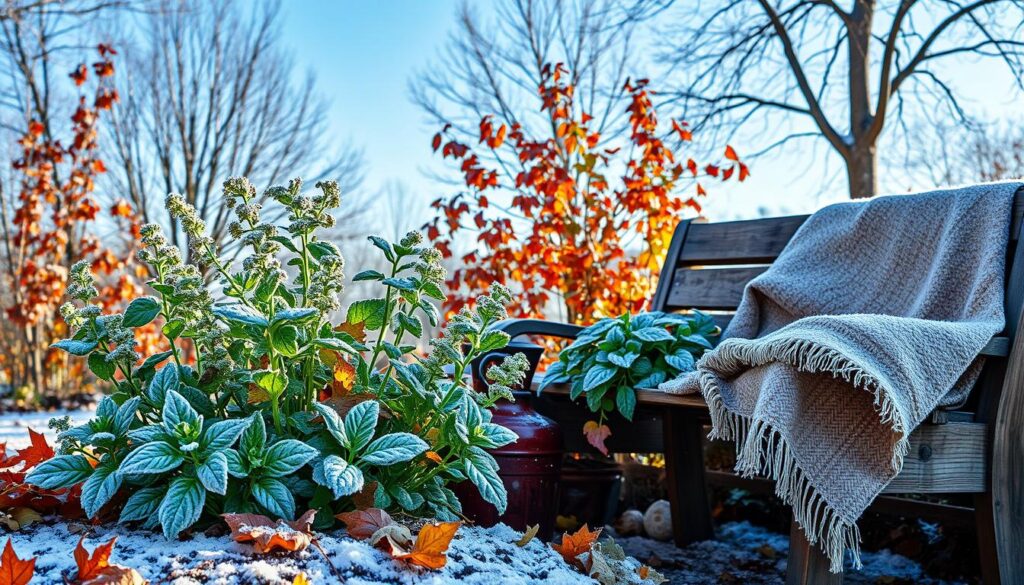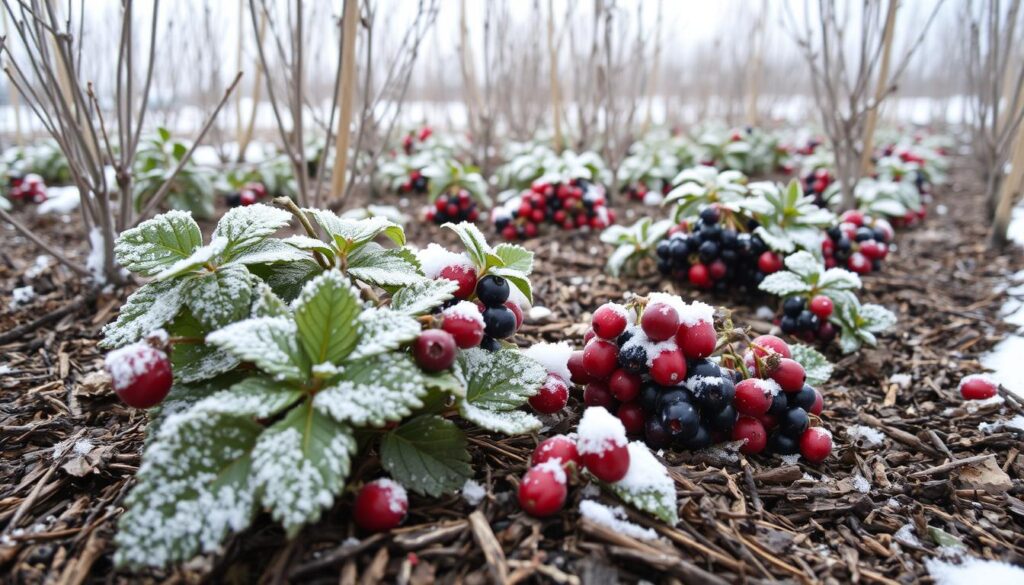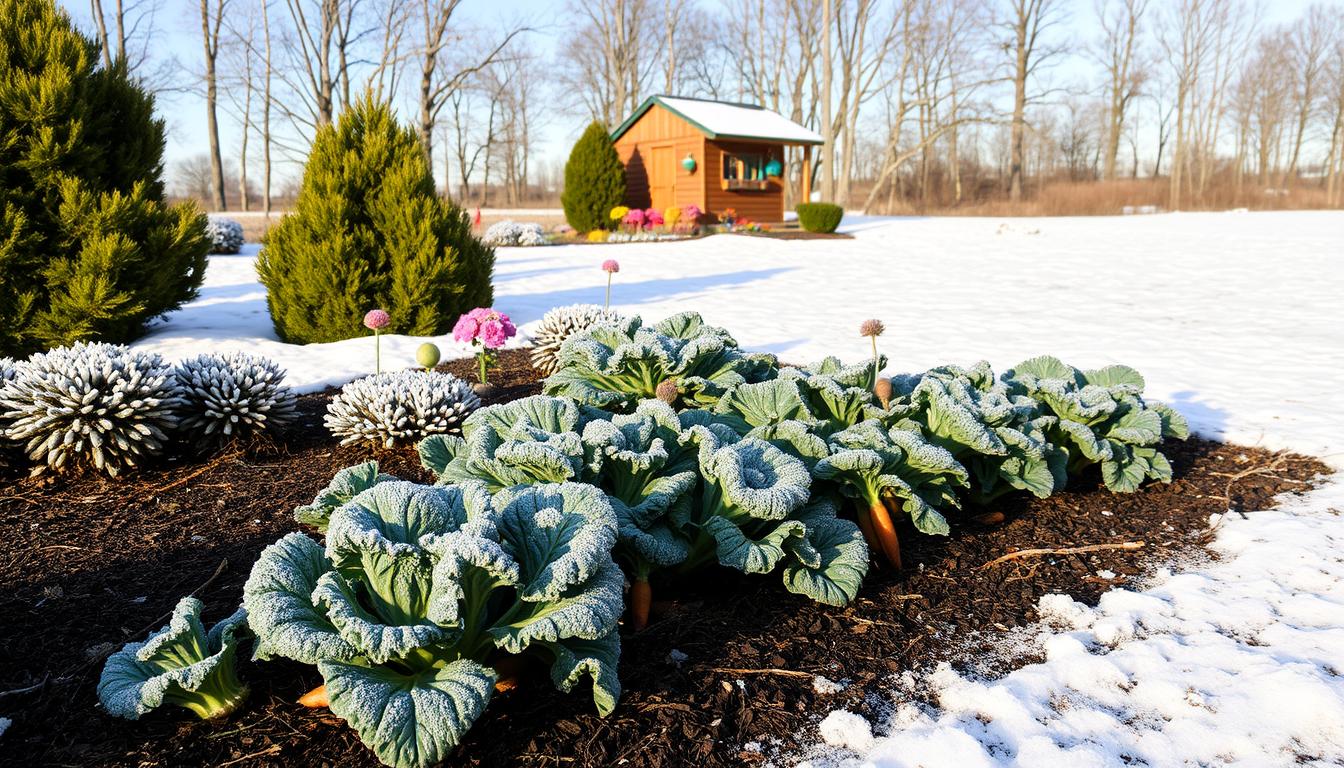This post contains affiliate links.
The change from summer’s colors to winter’s quiet is thought-provoking. Our gardens are more than just land; they’re a reflection of our hard work. As winter comes, we must protect our plants and prepare for spring.
My first frost was a shock, leaving my garden bare. I learned gardens need planning and care. This checklist and tips are key to keeping your garden safe and ready for spring.
Key Takeaways
- Winter garden care is essential to protect plants and ensure a healthy spring rebirth.
- Including compost and mulch helps build soil nutrition over winter.
- Protecting perennials, berry patches, and shrubs from harsh conditions is necessary.
- Covering garden beds with black plastic can help suppress weeds.
- Organizing and storing garden tools and equipment before winter prevents damage.
Fall Harvest: Preparing Vegetables for Winter
As the weather gets colder, it’s time to get your garden ready for winter. Taking care of your vegetables will help you enjoy a good harvest. It also keeps them safe from frost damage. Here’s how to protect your crops well.
Harvesting Tender Vegetables
Start by picking tender vegetables like tomatoes, zucchinis, and squash. These are very sensitive to frost and need to be picked before the first frost. Also, get rid of any sick plants to avoid pests later.
Protecting Hardy Vegetables
Vegetables like Brussels sprouts, kale, and collards can handle frost well. They even taste better after a frost. These are great for winter gardens because they’re tough. You can use mulch to keep the soil warm and protect the roots from cold.
Handling Semi-Hardy Vegetables
Cabbages and Swiss chard need extra help to stay safe from frost. Use row covers to keep them warm. Also, don’t forget about root crops and potatoes. Dig them up before the ground freezes and store them right to keep them fresh longer.
| Vegetable Type | Frost Tolerance | Protection Method |
|---|---|---|
| Tender Vegetables | Cannot tolerate frost | Harvest before frost; dispose of diseased plants |
| Hardy Vegetables | Withstand frost | May improve post-frost; mulch recommended |
| Semi-Hardy Vegetables | Tolerate light frost | Row covers; pre-ground freeze harvest |
Winterizing Herb Gardens
To get your herb garden ready for winter, you need to take a few key steps. This is important for both tender and hardy herbs. The steps you take will depend on the plant’s hardiness and your local climate.
Tender Herbs to Bring Indoors
Herbs like basil and rosemary need extra care in winter. They can’t handle frost, so they must be moved indoors. Place them on a sunny windowsill to keep them happy.
Make sure to water them regularly and give them enough sunlight. You can also grow new herbs from cuttings. This is a great way to save space indoors.

Caring for tender perennials like rosemary involves not only repotting but also protecting them from frigid winds, ensuring they receive ample sunlight indoors.
Perennial Herbs Requiring Minimal Protection
Many perennial herbs can make it through winter with little help. Sage, chives, and thyme are examples of hardy herbs. They can handle cold temperatures.
After the first hard freeze, prune these herbs down to 4 to 6 inches. Even in colder areas, a 3 to 6-inch layer of mulch can protect them.
It’s also smart to stop fertilizing herbs by mid- to late August. This helps them prepare for winter. A 2 to 3-inch layer of mulch can prevent soil damage from freezing and thawing.
| Herb | Winter Care | USDA Hardiness Zone |
|---|---|---|
| Rosemary | Repot and bring indoors, protect from wind | Above Zone 6 with Protection |
| Basil | Repot and bring indoors | Cannot withstand frost |
| Thyme | Prune and add mulch | Zone 5 and above |
| Sage | Add mulch and protect from windy conditions | Zone 5 and above |
Proper care in winter can make your herbs last longer and come back stronger in spring. By taking the right steps, you can enjoy fresh herbs all year.
Covering Garden Beds for Winter
Keeping your garden healthy during winter is key. Simple steps like covering your garden beds help. This keeps the soil rich, stops erosion, and guards against cold.
Adding Compost and Mulch
Adding compost and mulch in fall is a must. Compost gives nutrients to the soil over winter. Mulch, a 3-inch layer, insulates, stops weeds, and adds nutrients as it breaks down.
Raised beds, which drain well and warm up faster, benefit a lot. They stay fertile and ready for spring planting.
Using Cover Crops
Cover crops are great for winter garden beds. Crops like winter rye, wheat, or clover improve soil quality. They add nutrients when they decompose.
Raised beds, especially in places like Pennsylvania, love cover crops. They make the soil better. Simple covers like black plastic or old carpets also work. They stop weeds and get beds ready for spring.
For more tips and a guide on gardening tools, check out the Essential Guide to Best Gardening Tools.
Prepping Your Garden for Winter
As winter gets closer, making sure your garden is ready is key. A detailed winter gardening checklist helps you tackle all the important tasks. Start by clearing out dead plants and getting rid of weeds. This first step is crucial for preparing garden for cold weather.
Improving your soil is a big part of getting ready. Test your soil’s pH and adjust it to help nutrients get absorbed. Adding compost, especially a mix of brown and green, makes the soil better.
Using unsprayed grass clippings as mulch is also a good idea. It keeps the soil warm and moist. Making leaf mold from fallen leaves is another way to improve your garden’s health.
Wrapping young trees in burlap or tree wrap helps protect them from cold damage. This is especially important in very cold areas.
Planting cover crops like winter rye or clover helps prevent soil erosion. They also add organic matter to the soil. Using nitrogen-rich plants like legumes for cover crops in fall is a good idea. Covering raised beds with waterproof covers helps protect them from the weather. But, make sure not to dry out the soil too much.
| Climate Zone | Winter Temperature Range | Protective Measures |
|---|---|---|
| 6b | 0-20°F | Mulching, Burlap Wrap |
| Zone 5 | -10 to 20°F | Cover Crops, Mulching |
| Zone 4 | -20 to 10°F | Frost Covers, Tree Wraps |
In colder areas, it’s important to disconnect and drain hoses before it gets too cold. This prevents pipes from bursting and saves money. Also, check your tools and apply oil to prevent rust. Empty outdoor planters or move them to a safe place to avoid damage from freezing and thawing.
Preparing new garden beds in winter is a good idea. Use cardboard and compost to make a weed-free base for spring. Planting a mix of cover crop seeds adds microbes to the soil. Cover crops and composting under snow keep the soil healthy and protect it from winter.
Preparing Berry Patches
Preparing berry patches is key for a good harvest next year. Pruning is vital for keeping plants healthy in winter. For summer-bearing raspberries, keep only a few strong canes. Fall-bearing raspberries should be cut down after they fruit to grow better.

Blackberries and blueberries need special care. Mound soil around the base and mulch to stop frost damage. This keeps their roots safe from cold.
Strawberries are very sensitive to cold. Cover strawberry beds with straw to keep them warm. Straw protects plants, keeps soil moist, and fights off diseases.
Using these winter garden care tips will make your berry patches better. Protecting plants with soil mounding, pruning, and mulching helps them grow strong. Adjust your care based on your berry types for the best results every year.
Caring for Perennials
Taking care of your perennials in the fall is key to a healthy garden in spring. Preparing your garden for winter can make a big difference. Here are some important steps to help your perennials survive the cold.
Watering and Pruning Perennials
Start by watering your plants until the ground freezes. This helps them stay healthy during winter. Prune your perennials after the first hard freeze to keep them disease-free. Cut back plants like bee balm and hostas to a few inches above the ground.
Mulching and Protecting Against Frost
Add a thick layer of mulch after the soil freezes. This keeps roots warm and stops weeds. Use shredded leaves, bark chips, or straw for mulch. These materials protect your plants from freeze-thaw damage, especially in zones 7 and 8.
| Plant | Fall Care Required |
|---|---|
| Bee Balm | Cut back to a few inches above ground |
| Phlox | Cut back to a few inches above ground |
| Hostas | Remove spent foliage |
| Anemone | Cut back after a killing frost |
| Bearded Iris | Cut back after a killing frost |
By following these tips, you can make sure your garden is ready for spring. Winterizing your garden now will lead to a beautiful and healthy garden in the spring.
Winterizing Roses
Winterizing roses is key for protecting plants in winter and for a beautiful spring. In places like North Carolina, this starts around Labor Day. It involves soil prep, mulching, and covering plants.
Roses need good care before winter. In early October, clean up around them. Remove old mulch, leaves, and debris to prevent diseases.
Mulching and Covering with Chicken Wire
Mulching is vital for zone 7 roses. Use mushroom compost, pine, or hardwood mulch around the base. This keeps plants warm and safe.
For extra protection, cover the graft union with 5-6 inches of mulch. A chicken wire cage filled with leaves or mulch also helps. Mounding soil around the base protects tender bushes, especially grafted ones.
Protecting Climbing and Tea Roses
Climbing and tea roses need extra care in winter. Lay their canes flat and cover with mulch or pine branches. This stops damage from cold.
Water well in the fall to keep soil moist. Stop fertilizing by early September to avoid cold damage.
- Use organic fertilizers like Rose-Tone or Miracle-Gro for your roses.
- Improve clay soil with gypsum, common in the North Carolina Triad.
- Prune and clean up roses by late November to early December.
Follow these steps for healthy roses in spring. For more on growing plants in small spaces, see this container gardening guide.
Protecting Trees and Shrubs
Keeping your trees and shrubs safe during winter is key for a lively garden in spring. Here are some great tips for winter garden care.
Avoiding Late Pruning
Pruning is important, but timing matters a lot. Don’t prune your trees and shrubs late. Pruning too late can cause wounds to not heal right and make plants grow too soon. This is bad for them as winter gets closer. It’s better to wait until early spring to prune.
Shielding from Heavy Snow
Heavy snow can hurt trees and shrubs by bending and breaking branches. You can use wooden structures or chicken wire fencing with straw or burlap to help. Also, a layer of snow can keep soil warm and protect roots from freezing.
Using Tree Wraps to Prevent Damage
Wrapping young and thin-barked trees with tree wraps can stop sunscald. Sunscald happens when temperatures change too much. This is especially true in places like Minnesota, where road salts can harm plants. Keeping trees safe from sunscald and other winter damage means they’ll be healthier when it’s warmer again.
Using these methods in your winter garden plan will protect your trees and shrubs from harsh winter weather. By following these tips, you can make your garden more resilient and beautiful.
Conclusion
Preparing your garden for winter is key to keeping it alive and growing in the spring. By following a detailed winter gardening checklist, you protect your garden and prepare it for a brighter future. This checklist helps your garden not just survive but thrive.
Begin by winterizing your vegetable garden. Harvest what’s left and add compost to the soil. Plant cover crops like Winter Wheat to keep weeds away. Remember, removing diseased plants is vital to stop future problems, as shown in the garden winter preparation guide.
Don’t forget to care for your herbs, berry patches, and perennials during winter. Move tender herbs inside, insulate berry plants, and mulch perennials to protect them from frost. Roses, trees, and shrubs also need mulching and tree wraps to stay safe from cold and snow. Prune them late to keep them healthy and ready for spring.
Protecting your plants is just part of the job. Regular composting, tool maintenance, and planning new beds are also important. Turn your compost pile, clean and sharpen tools, and look for winter deals on gardening supplies. Supporting local wildlife with food and water can also help your garden in summer. For more tips, check out the onion gardening tips.
Every step you take this fall will pay off in the spring. With these tips, your winter garden prep will be both effective and rewarding. You’ll enjoy a beautiful, productive garden year after year.
FAQ
What are the essential steps for winter garden preparation?
How should I handle tender vegetables during fall harvest?
Which vegetables can withstand frost, and how should they be protected?
How do I prepare herb gardens for winter?
What is the best way to cover garden beds for winter?
How should berry patches be prepared for winter?
What care is required for perennials during winter preparation?
How can I winterize roses effectively?
What steps can be taken to protect trees and shrubs in winter?
This post contains affiliate links.

